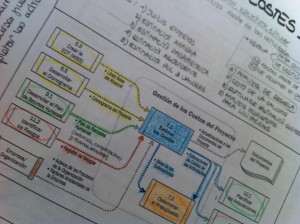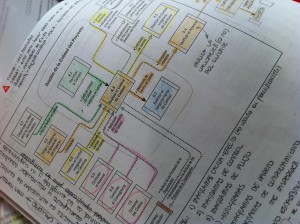9. Study, study and study
Follow the same system than you did at the beginning: study a subject using the PMBOK and the additional material from your preparatory course and then do the tests about that subject (with about 15 questions will be enough).
Repeat this sequence as many times as necessary and when you feel you are getting good scores doing this (remember 80%), then you can start doing exams.
Trying to do an exam too soon during your studying process will only lead you to frustration.
A study technique that helped me a lot to, understand and remember the different entries, tools, exits, formulas, etc. was to do diagrams and summaries about the flow charts of the 42 management project processes. Doing diagrams helps memorize and understand while you do them and then, when studying, it is very useful to have all the relevant information in the same place. And if you use colors/drawings/etc., they contribute to visual memory.


It is important to have a clear vision of what happens in every process group and in which order the planning is done, for that “Rita’s Process Chart” is very useful. Remember that planning is the only process group that follows a determined order.
You must memorize the 42 project managing processes, what process group and knowledge area they belong to. That magnificent table you have in the PMBOK.
Talking about memorizing, of course you have to do it, but you mustn’t get obsessed with that, the important thing is to understand. If you memorize it all, 3 days after the exam you will forget it. My advice is to understand why a certain tool is important in that process, what data I need to carry out a certain process, and not to sing the subject as a parrot because then it would have been useless.
In this stage you study by knowledge areas: integration, range, time, cost, quality, human resources, communication, risks and acquisitions, because that’s how the PMBOK is structured. There comes a time when, in a natural way, you start to relate some knowledge areas with others. There are two flows you must be clear about: the information flow (information about the work’s performance, performance reports and work’s performance measurements) and the deliverable flow: in which process construction must take place, in which validation takes place, in which process they are accepted by the client/sponsor and in which one takes place the formal acceptance and delivery. In the PMBOK there is no diagram explaining these flows between knowledge areas and you’ll have to visualize them and/or build them yourself. For me, having these two flows very clear was the key to understanding and to getting many exam questions right ;).
10. Do simulations of tests
The days before the exam it is recommendable to get in the situation and to sit 4 straight hours to do exams. This way:
- you’ll train concentration to be able to sit through 4 hours answering multiple choice questions.
- and you’ll know if you are ready to pass. You will be, as long as during your studying stage you get more than an 80% of score. The exam score is not that high and you can’t even know exactly what it is (at least I couldn’t find it), but if you study to get an 80%, the day of the exam you won’t have any problem.
Please let me at this point a couple of recommendations in case you want to study in Spanish:
- PMP® Certification course by CDP School, e-learning company of which I am a founder and teacher. El curso incluye el simulador de examen.
- In case you only need the simulator, PMP® Online Simulator by Daniel Echeverría. This is the simulator we use in the courses of CDP School.
11. Do the PMP® exam
When you get to your authorized center you must identify yourself and leave everything you carry in a locker. For the exam they give you 4 or 5 sheets of paper and two pencils, that’s everything you can enter the room with.
You begin by reading a tutorial about how to do the exam: how to answer the questions, how to mark a question to review it later, how to use the computer’s calculator (¿!), etc. You have 15 minutes to read the tutorial. It is recommendable to read it quickly (after all it’s not that complicated) and to use the remaining time in doing what’s called a mental emptying, what means, grab one of those sheets they gave you and write down the formulas, the process table with their knowledge areas and process groups, and any other information you want to keep close during the exam. This will help you to avoid your nervousness and the ticking clock on the higher right part of your screen from making you doubt and miss during the exam.
About the time rhythm, keep under control that you answer at least 50 questions per hour and you’ll have enough time to finish and to review the questions you marked.
After finishing the exam, you must answer a small survey. After finishing it, the program tells you immediately if you passed or not the exam with the result by process groups. You will be handed that report when you come out and in a couple of days, in your PMI’s dashboard you will also have the results with your PMP certification number.
12. Celebrate your success
As I have no doubts that if you follow these steps you will get your PMP certification, the last of them couldn’t be another one than celebrating because you are already a PMP.
After all, this is another project ended successfully.
May the force be with you!